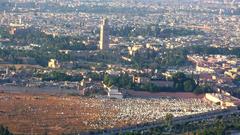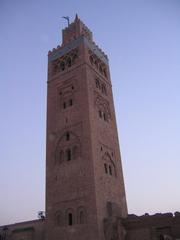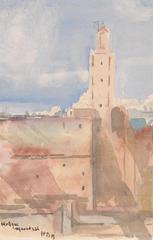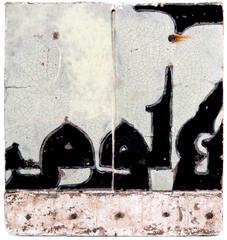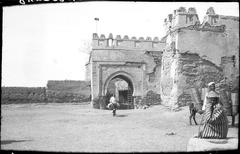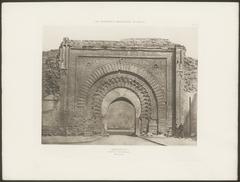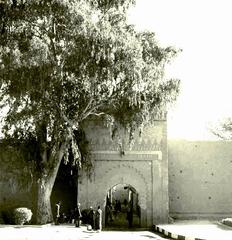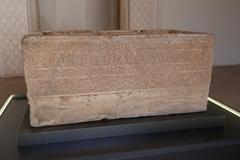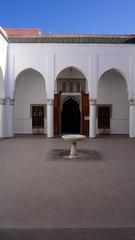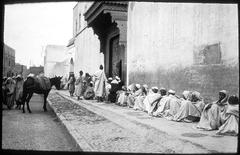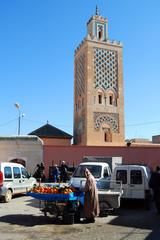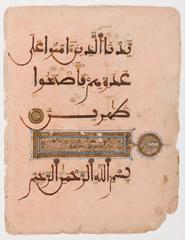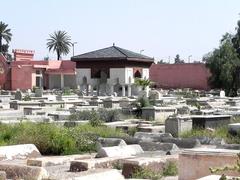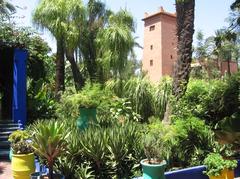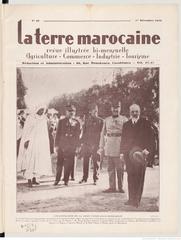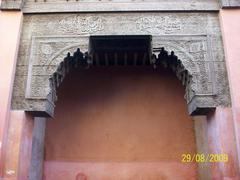
Visiting the Koutoubia Mosque: History, Tips, and Visitor Information
Date: 17/07/2024
Introduction to the Koutoubia Mosque
Table of Contents
- [Explore the History and Significance of Koutoubia Mosque](#explore-the-history-and-significance-of-koutoubia-mosqueexplore-the-history-and-significance-of-koutoubia-mosque)
- [Early Construction and Almohad Influence](#early-construction-and-almohad-influenceearly-construction-and-almohad-influence)
- [Rebuilding and Refinement under Yaqub al-Mansur](#rebuilding-and-refinement-under-yaqub-al-mansurrebuilding-and-refinement-under-yaqub-al-mansur)
- [Architectural Legacy and the Minaret’s Enduring Presence](#architectural-legacy-and-the-minarets-enduring-presencearchitectural-legacy-and-the-minarets-enduring-presence)
- [The Name “Koutoubia” and its Connection to Scholarship](#the-name-koutoubia-and-its-connection-to-scholarshipthe-name-koutoubia-and-its-connection-to-scholarship)
- [Visitor Information](#visitor-informationvisitor-information)
- [Discover the Architectural Marvels of Koutoubia Mosque](#discover-the-architectural-marvels-of-koutoubia-mosquediscover-the-architectural-marvels-of-koutoubia-mosque)
- [The Minaret - A Beacon of Faith and Architectural Prowess](#the-minaret---a-beacon-of-faith-and-architectural-prowessthe-minaret---a-beacon-of-faith-and-architectural-prowess)
- [Design and Decoration](#design-and-decorationdesign-and-decoration)
- [Architectural Significance](#architectural-significancearchitectural-significance)
- [The Prayer Hall - A Sanctuary of Tranquility and Grandeur](#the-prayer-hall---a-sanctuary-of-tranquility-and-grandeurthe-prayer-hall---a-sanctuary-of-tranquility-and-grandeur)
- [Layout and Dimensions](#layout-and-dimensionslayout-and-dimensions)
- [Architectural Highlights](#architectural-highlightsarchitectural-highlights)
- [The Gardens - An Oasis of Peace and Reflection](#the-gardens---an-oasis-of-peace-and-reflectionthe-gardens---an-oasis-of-peace-and-reflection)
- [Historical Significance](#historical-significancehistorical-significance)
- [Materials and Construction Techniques](#materials-and-construction-techniquesmaterials-and-construction-techniques)
- [Visitor Information](#visitor-informationvisitor-information-1)
- [Travel Tips](#travel-tipstravel-tips)
- [Nearby Attractions](#nearby-attractionsnearby-attractions)
- [FAQ](#faqfaq)
- [The Minaret - A Beacon of Faith and Architectural Prowess](#the-minaret---a-beacon-of-faith-and-architectural-prowessthe-minaret---a-beacon-of-faith-and-architectural-prowess)
- [Conclusion](#conclusionconclusion)
- [References](#referencesreferences)
Explore the History and Significance of Koutoubia Mosque
Early Construction and Almohad Influence
The Koutoubia Mosque (جامع الكتبية), a prominent landmark in Marrakesh, Morocco, boasts a rich history intertwined with powerful dynasties and architectural grandeur. Its story offers a glimpse into the city’s evolution and its enduring spiritual significance.
The mosque’s history dates back to the mid-12th century, during the reign of the Almohad Caliph Abd al-Mu’min. He commissioned the first Koutoubia Mosque around 1147, shortly after conquering Marrakesh. This initial structure, however, was found to be incorrectly oriented towards Mecca and was subsequently demolished.
Rebuilding and Refinement under Yaqub al-Mansur
The mosque we see today is largely attributed to the reign of Yaqub al-Mansur, Abd al-Mu’min’s grandson. He ordered its reconstruction in 1199, aiming for a grander and more accurately oriented mosque. This period marked a golden age for the Almohads, and the Koutoubia Mosque became a symbol of their burgeoning empire, reflecting their power and commitment to Islamic scholarship.
Architectural Legacy and the Minaret’s Enduring Presence
The mosque’s design, heavily influenced by the architectural styles prevalent in Cordoba and Seville, showcases the Almohads’ sophisticated taste. The hypostyle prayer hall, a hallmark of Islamic architecture, features rows of columns and arches, creating a sense of expansive space and tranquility.
However, the most iconic feature of the Koutoubia Mosque is undoubtedly its towering minaret. Standing at approximately 77 meters (253 feet) tall, it dominates the Marrakesh skyline and serves as a visual anchor for the entire city. The minaret’s intricate decorative elements, including floral motifs, calligraphy bands, and arched windows, exemplify the intricate craftsmanship of the Almohad artisans.
The Name “Koutoubia” and its Connection to Scholarship
The name “Koutoubia” itself speaks to the mosque’s historical role as a center of knowledge. Derived from the Arabic word “kutub,” meaning “books,” it refers to the numerous booksellers and manuscript vendors that once surrounded the mosque. This bustling marketplace of ideas further cemented the Koutoubia Mosque’s reputation as a beacon of intellectual and spiritual pursuit.
Visitor Information
- Tickets and Visiting Hours: While non-Muslims are not permitted inside the mosque, the surrounding gardens are open to visitors daily from 8 AM to 8 PM. No tickets are required for entry.
- Travel Tips: The mosque is centrally located in Marrakesh, making it easily accessible by public transport or taxi. Consider visiting early in the morning or late in the afternoon to avoid crowds.
- Nearby Attractions: After exploring the Koutoubia Mosque, take a stroll to the nearby Jemaa el-Fnaa square, a bustling marketplace filled with food stalls, entertainers, and shops.
Discover the Architectural Marvels of Koutoubia Mosque
The Minaret - A Beacon of Faith and Architectural Prowess
Dominating the Marrakesh skyline, the Koutoubia Minaret is the mosque’s most prominent feature, visible from miles away. Towering at approximately 77 meters (253 feet) high, it is the tallest structure in Marrakesh and serves as a symbol of the city. The minaret’s construction, primarily using sandstone, reflects the Almohad dynasty’s penchant for grandeur and their sophisticated understanding of engineering.
Design and Decoration
The minaret’s square-shaped base transitions seamlessly into an octagonal shaft, a characteristic element of Moorish architecture. This shaft is adorned with intricate decorative patterns, showcasing the mastery of Almohad artisans. The decorations, carved into the sandstone, include:
- Sebka: Interlocking arches forming a grid-like pattern, a hallmark of Islamic architecture.
- Floral motifs: Stylized representations of flowers and plants, reflecting the Islamic appreciation for nature’s beauty.
- Calligraphic bands: Verses from the Quran, rendered in elegant Arabic script, add a spiritual dimension to the aesthetic appeal.
Architectural Significance
The Koutoubia Minaret’s design served as a prototype for other minarets, not only in Morocco but also across the Islamic world. The Giralda in Seville, Spain, and the Hassan Tower in Rabat, Morocco, bear a striking resemblance to the Koutoubia Minaret, highlighting its far-reaching influence.
The Prayer Hall - A Sanctuary of Tranquility and Grandeur
While the minaret captures the eye from afar, the prayer hall, or musalla, offers a glimpse into the mosque’s spiritual heart. Supported by massive pillars and graceful arches, the hall is designed to accommodate a large number of worshippers.
Layout and Dimensions
The prayer hall follows a hypostyle plan, characterized by rows of columns supporting a roof. It is oriented towards Mecca, the holiest city in Islam, ensuring that worshippers face the correct direction during prayer. The hall’s vast dimensions, measuring 90 meters (295 feet) long and 60 meters (197 feet) wide, reflect the mosque’s importance as a center for communal prayer.
Architectural Highlights
- Horseshoe arches: A distinctive feature of Moorish architecture, these arches add a sense of grandeur and spaciousness to the hall.
- Ribbed domes: Located above the mihrab (prayer niche) and the minbar (pulpit), these domes enhance the acoustics of the hall, amplifying the imam’s voice during sermons.
- Courtyard: A central courtyard, surrounded by arched galleries, provides a serene space for ablutions before prayer.
The Gardens - An Oasis of Peace and Reflection
Surrounding the mosque are lush gardens, offering a tranquil respite from the bustling city. These gardens, planted with palm trees, orange trees, and other fragrant flora, create a serene atmosphere conducive to contemplation and spiritual reflection.
Historical Significance
The gardens were originally part of the Almohad palace that once stood adjacent to the mosque. They served as a place of leisure and recreation for the ruling elite. Today, the gardens are open to the public, providing a peaceful escape for both locals and tourists.
Materials and Construction Techniques
The Koutoubia Mosque’s enduring beauty is a testament to the skill of Almohad craftsmen and the quality of materials used in its construction.
- Sandstone: The primary building material, quarried from nearby Gueliz, gives the mosque its characteristic reddish-pink hue. Sandstone’s durability has allowed the mosque to withstand the test of time, preserving its architectural integrity.
- Brick: Used in conjunction with sandstone, particularly in the construction of arches and vaults, brick provided additional structural support.
- Lime mortar: A mixture of lime, sand, and water, served as a binding agent, holding the sandstone blocks and bricks together.
The construction of the Koutoubia Mosque involved sophisticated engineering techniques, evident in the minaret’s stability and the prayer hall’s expansive roof. The use of arches, vaults, and domes not only enhanced the mosque’s aesthetic appeal but also distributed weight effectively, ensuring its structural integrity.
Visitor Information
For those planning to visit the Koutoubia Mosque, here are some practical details:
- Visiting Hours: The mosque is open to visitors from 9:00 AM to 6:00 PM daily, except during prayer times.
- Tickets: Entry to the mosque is free, but donations are appreciated to help with the maintenance of the site.
- Accessibility: The mosque is wheelchair accessible, with ramps provided at various entry points.
Travel Tips
To make the most of your visit to the Koutoubia Mosque, consider the following tips:
- Dress Code: Modest clothing is required. Men should avoid shorts, and women should cover their heads and wear long skirts or pants.
- Guided Tours: Consider joining a guided tour to gain deeper insights into the mosque’s history and architecture.
- Photography: Photography is allowed, but be respectful of worshippers and avoid using flash.
Nearby Attractions
While in Marrakesh, explore other historical sites nearby:
- Jemaa el-Fnaa: A bustling market square located just a short walk from the mosque.
- Saadian Tombs: A historic royal necropolis with intricate decorations.
- Bahia Palace: A beautiful palace with stunning gardens and architecture.
FAQ
What are the visiting hours of Koutoubia Mosque? The mosque is open from 9:00 AM to 6:00 PM daily, except during prayer times.
Are there guided tours available at Koutoubia Mosque? Yes, guided tours are available and highly recommended for a comprehensive understanding of the mosque’s history and architecture.

